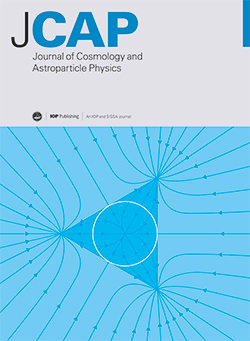Limits on dark matter, ultralight scalars, and cosmic neutrinos with gyroscope spin and precision clocks
IF 5.3
2区 物理与天体物理
Q1 ASTRONOMY & ASTROPHYSICS
Journal of Cosmology and Astroparticle Physics
Pub Date : 2025-03-21
DOI:10.1088/1475-7516/2025/03/049
引用次数: 0
Abstract
Dark matter (DM) within the solar system induces deviations in the geodetic drift of a gyroscope spin due to its gravitational interaction. Considering a constant DM density as a minimal scenario, we constrain DM overdensity within the Gravity Probe B (GP-B) orbit around the Earth and for Earth's and Neptune's orbits around the Sun. The presence of electrons in gravitating sources and test objects introduces an electrophilic scalar-mediated Yukawa potential, which can be probed from the measurement of geodetic drift as well as using terrestrial and space-based precision clocks. We derive projected DM overdensity (η) limits from Sagnac time measurements using onboard satellite clocks, highlighting their dependence on the source mass and orbital radius. The strongest sensitivity, η ∼ 4.45 × 103, is achieved at Neptune's orbit (∼ 30 AU), exceeding existing constraints. Correspondingly, the cosmic neutrino overdensity is ξ ∼ 5.34 × 1010, surpassing results from KATRIN and cosmic ray studies. The strongest sensitivity on the electrophilic scalar coupling, g ∼ 7.09 × 10-24, is achieved for a scalar mass mφ ≲ 1.32 × 10-18 eV. This result, obtained from the projected precision clock studies probing non-gravitational potentials, is competitive with the leading bounds from fifth-force searches. These precision measurements offer a robust framework for testing gravity at solar system scales and probing DM in scenarios inaccessible to direct detection experiments.利用陀螺仪自旋和精密时钟对暗物质、超轻标量和宇宙中微子的限制
本文章由计算机程序翻译,如有差异,请以英文原文为准。
求助全文
约1分钟内获得全文
求助全文
来源期刊

Journal of Cosmology and Astroparticle Physics
地学天文-天文与天体物理
CiteScore
10.20
自引率
23.40%
发文量
632
审稿时长
1 months
期刊介绍:
Journal of Cosmology and Astroparticle Physics (JCAP) encompasses theoretical, observational and experimental areas as well as computation and simulation. The journal covers the latest developments in the theory of all fundamental interactions and their cosmological implications (e.g. M-theory and cosmology, brane cosmology). JCAP''s coverage also includes topics such as formation, dynamics and clustering of galaxies, pre-galactic star formation, x-ray astronomy, radio astronomy, gravitational lensing, active galactic nuclei, intergalactic and interstellar matter.
 求助内容:
求助内容: 应助结果提醒方式:
应助结果提醒方式:


